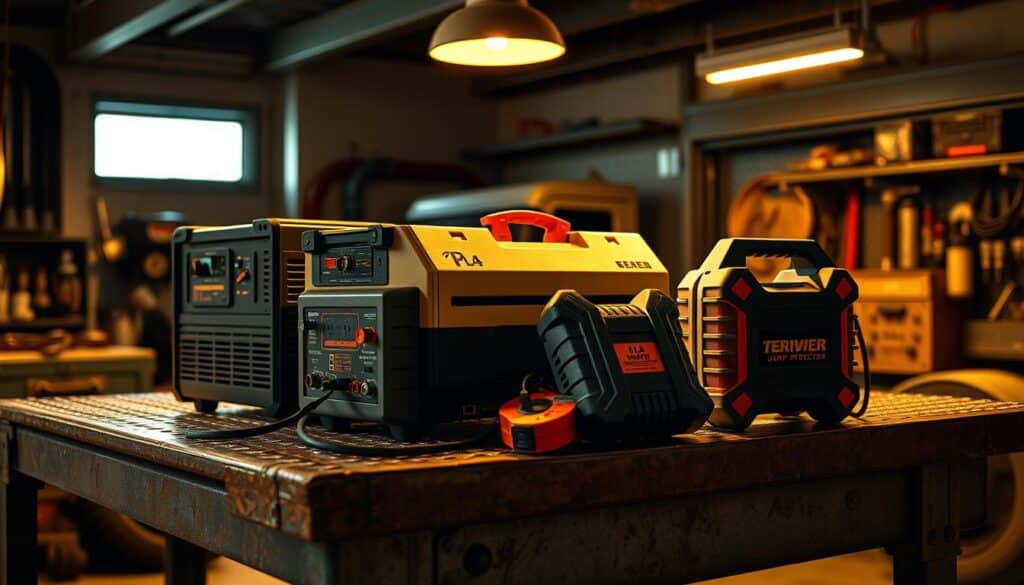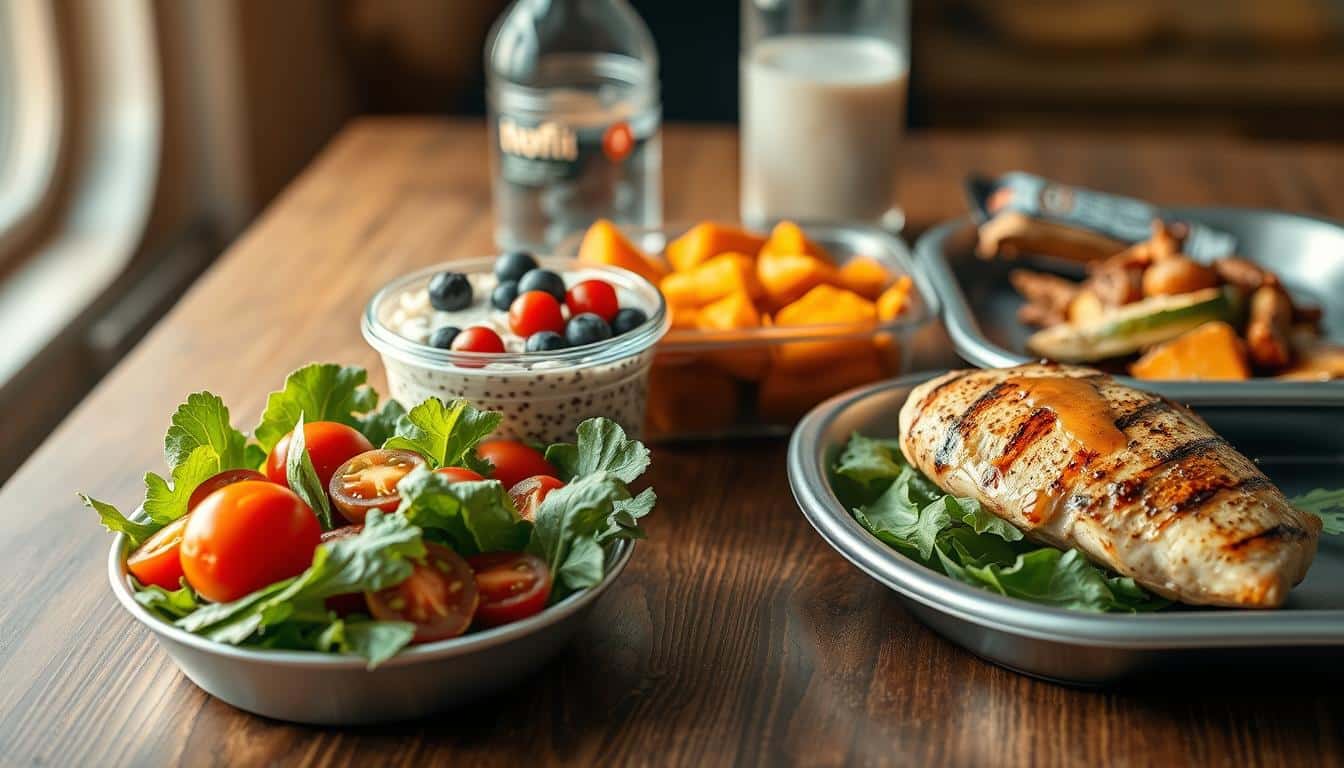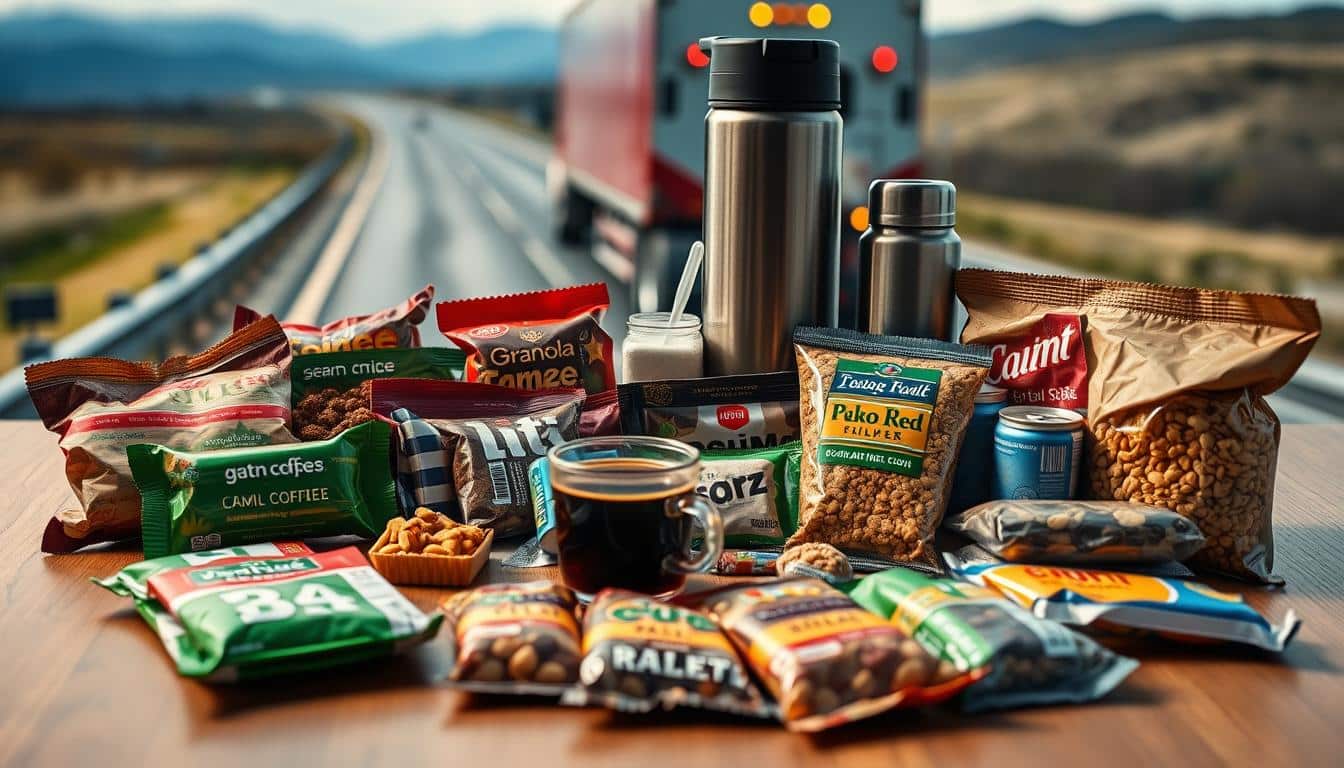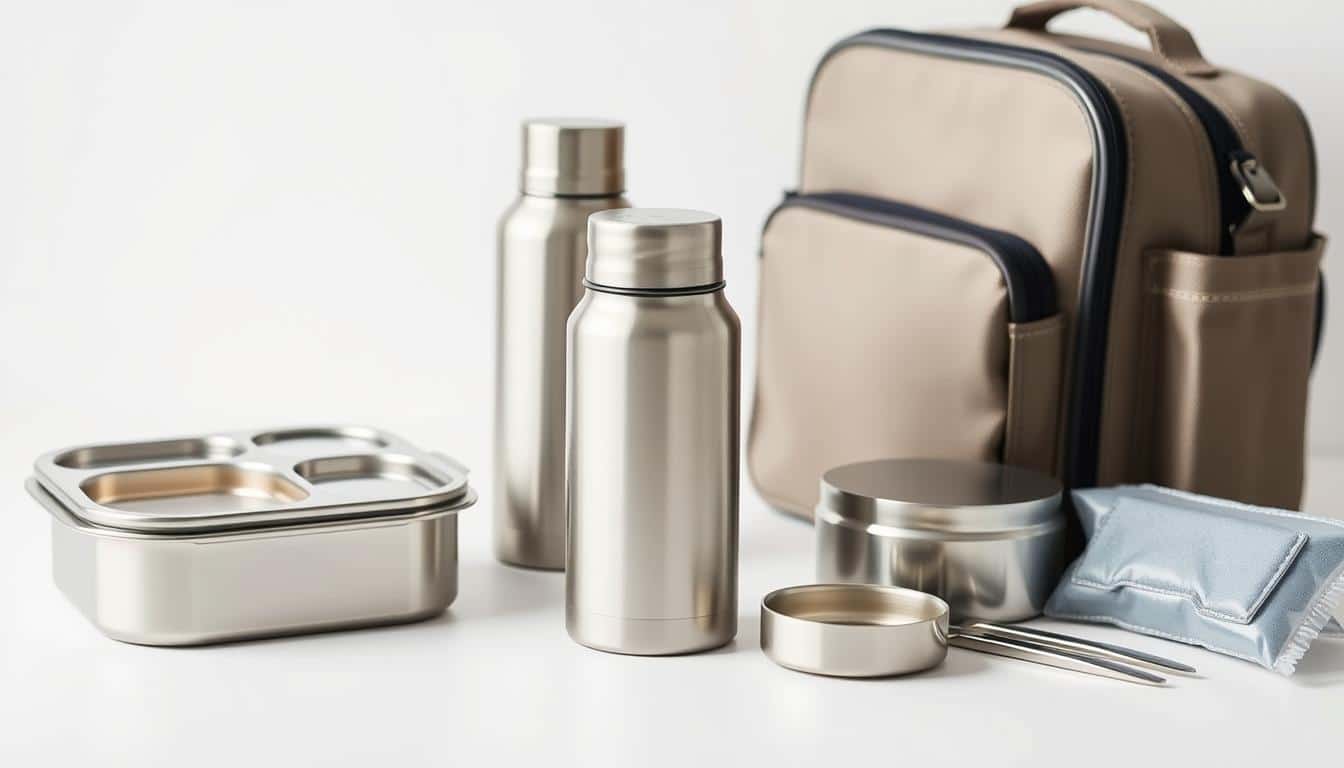Being on the road doesn’t mean missing out on tasty meals. With the right tools, truckers can enjoy healthy eating, save cash, and skip the usual fast food.
Must-have items for trucker kitchens include small fridges and versatile microwaves. There are also crockpots, electric skillets, and portable ovens. Brands are key, like Schneider, which fits trucks with fridges. Some companies even provide power inverters for big appliances.
These gadgets make cooking in the truck easy. A mini-fridge keeps food fresh. With a slow cooker, dinner’s ready when you are. And a blender is perfect for quick breakfasts. Picking the right cooking tools helps truck drivers eat well and feel better on long trips.
Why In-Cab Cooking Tools Matter for Truckers
Having simple cooking tools in the sleeper cab can really change life on the road. It lets drivers choose when to eat, save time, and avoid truck-stop food. Choosing the right appliances and containers can turn a tiny space into a functional kitchen.
Health and budget benefits
Cooking inside the cab encourages eating fresh foods like fruits, veggies, and lean meats instead of fast food. Eating better can improve health and give truckers more constant energy.
Using stackable food containers for meal prep keeps things tidy and helps save fridge space. This way of preparing meals can help avoid fast food temptations and cut down on food spending. It helps drivers save money and eat healthier.
Time management and convenience
Gadgets like slow cookers, electric lunch boxes, and microwaves make it easy to cook without much fuss. A crockpot, for instance, can cook dinner while a driver is making a delivery.
Portable kitchen devices that use 12V power or a small inverter help save time. This means less time looking for food, which improves travel plans and rest times.
Regulatory and safety considerations
Make sure kitchen gadgets match the truck’s electrical setup before fitting them. For instance, some trucks can handle powerful inverters, but others might not and could be overloaded.
Choose kitchen tools with safety in mind, like slow cookers with locking lids and microwaves that securely latch. Fixing them firmly, ensuring they are well-ventilated, and keeping them clean minimizes dangers like fires and germs.
Refrigeration and food storage options
Keeping food fresh on the road starts with the right gear and a simple plan. Pick a cooling solution that fits your sleeper layout, power limits, and meal routine. Measure shelves and cabinets before you buy so your gear and groceries fit without waste.
Mini-fridges and electric coolers serve different needs. A mini fridge keeps food cold longer and is great for meal prep. Schneider trucks come equipped with refrigerators for drivers who like cooking.
Electric coolers for trucks are more about being easy to carry and using less power. Look into options like the Wagan 12V Personal Cooler/Warmer, which cools things below the outside temperature and can also warm food up to 140°F. Make your choice based on the available space, power, and how much you need to store.
- Measure cab/wall space before purchase.
- Match fridge capacity to weekly shopping habits.
- Check power draw and hardwire or use a dedicated 12V outlet.
Being organized increases space. Use stackable food containers to fit more in your fridge and cabinets. Choose compact glass or BPA-free plastic ones that nest when empty and are safe for reheating.
Label your containers with what’s inside and when you made it. Airtight lids help control smells and spills, making your cab cleaner and reducing waste.
- Use different colored lids or labels for breakfast, lunch, and dinner.
- Store raw meats on the lowest shelf to avoid drips.
- Keep leftovers in portioned, stackable packs for quick reheating.
Useful tips for long haul cold storage help avoid spoilage and save money. Always have a small fridge thermometer handy to keep an eye on temperatures and maintain safe storage levels.
Consider bringing along freezer packs or a small freezer section. Remember to shop according to your fridge’s size; only buy perishables in amounts you can consume within safe periods to ensure food stays fresh.
- Place dairy and meats in the coldest zone of the fridge.
- Rotate stock by date and use oldest items first.
- Use reusable food containers sized for single meals to cut waste.
Microwave choices for the sleeper cab
When choosing a microwave for your sleeper cab, focus on balance. You’ll need to consider power, size, and safety. Truckers have the choice of 12V microwaves or regular 110V types that work with an inverter. Think about what you eat daily, how much space you have, and your truck’s power system.
12V and 110V options
12V models plug right into the truck’s cigarette or accessory outlet. These are made for trucks and are simpler to use on the go. For example, RoadPro makes 12V microwaves that are perfect for small meals. They’re cooler, use less power, but take longer to cook than bigger microwaves.
For those who’ve installed an inverter, a 110V microwave is often preferred. Black+Decker produces compact models that go well with a 2,000-watt inverter. There are also hybrid microwaves. They can use both 12V and 110V, giving you choices while traveling.
Key features to compare
- Power (watts): 12V microwaves are slower but save energy with 300–750W. A 110V microwave ranges from 800–1200W, cooks faster, but uses more power.
- Size/capacity: Check how much space you have first. A compact model at 0.5 cu ft usually fits. Make sure it can hold your plates and taller containers.
- Controls and usability: Find microwaves with easy-to-use controls. Look for useful features like presets, defrost options, timers, and trays you can remove for cleaning.
- Safety and durability: Choose microwaves with UL certification, strong latches, and designs that can handle being on the road.
Placement and ventilation
Make sure your microwave is securely mounted to avoid accidents. It should be placed on a shelf or bracket. It needs to be low enough so you don’t hit your head and high enough for easy use.
Keep the area around your microwave clear to let it vent heat properly. Don’t cover up the microwave’s vents or the truck’s. Planning for noise is also important. A quieter microwave makes for a more comfortable rest in your sleeper cab.
Cooktops, grills, and electric skillets for versatile cooking
Picking the right tools can turn your sleeper cab into a handy kitchen. Small cooktops, grills, and electric skillets increase what you can cook. They fit well in small spaces. Consider their power needs, size, and how they deal with movement and spills.

Electric skillets and portable grills
Electric skillets heat up evenly and give you space for pancakes, stir-fries, and one-dish meals. They are a good choice for trucks, especially with the right power inverter.
George Foreman-style grills are perfect for fast meals. They have nonstick plates that make cooking and cleaning quicker. If you use a George Foreman grill in your truck, make sure your inverter can handle it. Some work with a 2,000W inverter without any trouble.
- Options with low wattage, like the Dash Mini Waffle Maker (about 350W), simplify making breakfast on the road.
- Pick items with lids that lock to avoid spills while you’re parked or driving short distances.
Safety and clean-up hacks
Start with safe placement for cooktops in your cab. Put devices on stable surfaces away from cloth and air vents. Always have a small fire extinguisher nearby. Never leave a cooking appliance on without watching it.
To make cleaning easier, use aluminum foil on grill plates or removable nonstick pieces. Slow-cooker bags reduce cleaning time and prevent messes. Always have antibacterial wipes and paper towels on hand for quick cleans.
- Using disposable plates and plastic forks and knives means less washing up.
- Wait for appliances to cool down before you put them away to keep them in good condition and prevent injuries.
- Wrap up cords neatly and store your cooking gear in a dry place to make them last longer.
Slow cookers and pressure cookers for set-and-forget meals
For truckers, cooking in-cab must match their schedule. Slow cookers and pressure cookers are ideal. They let drivers prepare a meal, hit the road, and come back to something hot. These tools save money, reduce fast food stops, and offer more meal variety on long trips.
Benefits of small slow cookers
Pick a small crockpot that fits in the sleeper cab and has a locking lid. These 2–3 quart models are budget-friendly and easy to travel with. Drivers can put in stew ingredients before starting a shift and return to a meal that’s ready to eat.
Truckers using slow cookers prefer liners for easy cleaning. They enjoy one-pot recipes for simple storage too. Great meal options include pot roasts, soups, and casseroles. These dishes stay tasty even after reheating at the end of a long day.
Why electric pressure cookers earn space in the cab
Electric pressure cookers make cooking faster and offer more cooking methods. A compact model can pressure cook, slow cook, sauté, steam, and keep food warm. This is great if your inverter can handle the power needed.
Look for an instant pot model or a similar one with around 700W. Such units come with safety features. These features make them less worrying to use while driving or when left alone.
Practical tips for set-and-forget truck meals
- Choose meals like stews and chili. They travel and reheat well.
- Opt for locking lids and silicone liners. This avoids spills and makes cleanup quick.
- Check your inverter’s wattage before getting a pressure cooker for your truck.
- Keep cooked food in stackable containers. This makes it easy to grab a meal between shifts.
Both crockpot and electric pressure cooker options are great for truckers. Pick the one that matches your truck’s power and your food preferences. This approach makes meals simple, safe, and enjoyable while on the road.
Portable ovens, electric lunch boxes, and mini ovens
Traveling gets easier for drivers who like hot meals but don’t have a full kitchen. There are small electric lunch boxes and mini ovens perfect for the road. They must fit the truck’s space, hold your meal, and work with the truck’s power.
Electric lunch boxes and portable ovens
- Electric lunch boxes use 60W to 80W and warm up food in 20–30 minutes. Most can switch between 12V/24V and 110V with an adapter, ideal for long trips.
- Choose options with stainless steel trays of about 1.5L and lids that don’t leak. This makes cleaning easier and stops spills on the road.
- Some portable ovens for trucks fit bigger dishes and warm food like an oven, great for casseroles and baked goods.
- HOTLOGIC mini ovens work with certain container sizes and keep meals warm automatically. They’re good for ready-made meals and foods from the deli.
When to choose a mini oven over a microwave
- Mini ovens and HOTLOGIC reheat food evenly, avoiding the hot spots microwaves cause. They’re better for dishes like lasagna, stews, and sealed meals.
- In many trucks, power is limited, so low-watt devices like mini ovens use less electricity. This is easier on the truck’s electrical system than a microwave.
- Microwaves are best for quick heating and defrosting. But mini ovens offer gentle warming, are easier to use, and work better for baked or layered dishes.
- For drivers who value portability and spill-proof storage, an electric lunch box or a compact portable oven is often the best choice. They offer great convenience and performance.
Small appliances and extras that boost meal variety
Smart extras can turn simple foods into a range of meals without taking too much space. Look for tools that do more than one thing, save you time, and are okay for your truck’s power. Good choices make your breakfasts, snacks, and quick meals better on the road.
Personal blenders and smoothie makers
Personal blenders help drivers eat more fruits and veggies with smoothies, sauces, and soups. They often use the drink cup as the blender to cut down on washing up. Choose ones that are small and use less power to fit your truck’s outlets and storage space.
Dash appliances and specialty tools
- The Dash mini waffle maker cooks quick breakfasts and tiny sandwiches. It’s small and uses about 350W, fitting most trucks.
- A travel spice rack adds a lot of flavor to simple dishes. Basics like salt, pepper, and garlic powder can refresh leftovers.
- Combo appliances like a pressure cooker/air fryer save space by doing multiple things. Always check the power use and safety features.
Utensils, cutting boards, and disposables
Having a small cutting board is key for making sandwiches and cutting veggies. Options that are thin or foldable are easy to store.
- Choose trucker kitchen tools that last and don’t take up much room: a folding spatula, a small knife with a cover, and tongs that resist heat.
- Using disposable plates, cutlery, and pans can make cleanup quicker. Antibacterial wipes and slow-cooker bags help keep things clean and safe.
Power, wiring, and safety essentials for in-cab cooking
Getting the right power and safety setup is key for safe in-cab cooking. Always check your truck’s electrical safety and outlets before you buy any cooking equipment. Doing this can stop blown fuses, dead batteries, and fire dangers down the line.

Matching appliance power to the truck electrical system
- First, know what your truck can handle. For example, many Freightliner Cascadia trucks have a 2,000-watt PowerDrive inverter. Check if your vehicle uses a 12V system, has a built-in inverter, or needs shore power.
- Then, look at the wattage. A waffle maker might need 350W, a pressure cooker 700W, and microwaves between 800–1200W. Make sure your truck’s power can handle these appliances without issues.
- Lastly, choose the right equipment. Seek out appliances made for 12V or those with multi-voltage cords. If you’re getting an inverter for your truck’s microwave, it should give out more power than the microwave needs and have the right kind of fuse.
Installation and secure mounting
- Make sure appliances are mounted securely to avoid accidents or damage while driving. It’s important to measure your sleeper area to ensure you can fit everything without blocking air vents.
- Go for appliances with safety features like locking lids and strong latches to prevent spills. Whenever possible, use brackets and non-slip mats.
- It’s crucial to use the right wiring, inline fuses, and a high-quality inverter. Always follow the guidelines given by both the appliance and your vehicle to minimize electrical risks.
Cleaning, odor control, and food safety
- Clean up using antibacterial wipes and removable pieces. Using slow-cooker liners and aluminum foil helps reduce cleanup time and keeps smells away.
- Be smart with food storage. Keep things in airtight containers, label them with dates, and use a fridge thermometer to check temperatures. This helps prevent food from going bad and keeps you healthy.
- Keep trash and pests under control. Always seal off garbage bags and toss them regularly. Clean your cooking area often to keep pests and bad odors at bay.
Follow these tips to keep your truck, appliances, and meals safe. Planning ahead for power, making sure everything is mounted securely, and keeping things clean makes the sleeper cab a safe, comfy place for road life.
Conclusion
Setting up your sleeper cab with top-notch cooking gear makes for healthier and more practical life on the road. Items like a compact fridge, a suitable microwave or 12V cooker, a mini slow cooker or multi-cooker, and portable cooktops are essential. They allow truckers to make nutritious meals, which are better and cheaper than fast food.
Before purchasing, check your truck’s power system and how much space you have. Pick between 12V or 110V microwaves, electric lunch boxes with low power need, and mobile grills according to your inverter’s power. Adding stackable containers, travel spice racks, liners for slow cookers, and antibacterial wipes improves both convenience and cleanliness without taking up much space.
Correct installation and use of these devices, alongside secure mounting, right ventilation, and keeping food safe, truly transforms your cab into a kitchen. By equipping your truck for cooking, you enjoy better food, spend less on meals, and have more control over your diet and schedule on long trips.
FAQ
What in-cab cooking tools are essential for truckers?
How do in-cab appliances improve health and budget for drivers?
What time-management benefits do set-and-forget appliances provide?
What electrical and safety considerations should drivers know?
Mini-fridge or electric cooler—which is better for a sleeper cab?
How can I organize food with limited fridge space?
What cold-storage tips help on long hauls?
What 12V and 110V microwave options exist for trucks?
Which microwave features matter most in a sleeper cab?
Where should I place a microwave in the sleeper cab?
Are electric skillets and portable grills practical for truckers?
How can I minimize mess and spills when cooking in the cab?
Why are crockpots a good choice for truck drivers?
When should I choose a pressure cooker or multi-cooker?
What are electric lunch boxes and mini ovens good for?
When is a mini oven better than a microwave?
Are personal blenders useful on the road?
Which small extras improve meals without taking much space?
How do I ensure appliances match my truck’s electrical system?
What are best practices for installing and mounting appliances?
How do I keep the cab clean and control odors when cooking?
What small accessories save time and reduce waste?
Can fleets provide in-cab appliances and power options?
How do I pick the right appliance wattage for my inverter?
Are hybrid or multi-voltage appliances worth considering?
What foods store and reheat best for truck life?
How can I avoid electrical issues when adding appliances?
What safety features should I look for in in-cab appliances?
Content created with the help of Artificial Intelligence.



